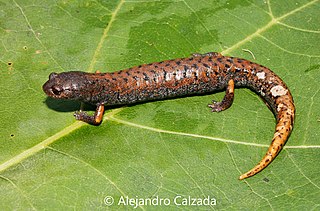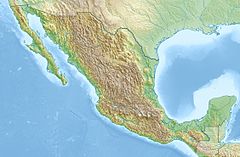
Plectrohyla guatemalensis, also known as the Guatemala spikethumb frog, is a species of frog in the family Hylidae. It occurs in the highlands of the Sierra Madre from southeastern Chiapas, Mexico, and eastward through the central and southwestern highlands of Guatemala to northwestern El Salvador as well as the Sierra de Nombre de Dios in north-central Honduras. It might be a composite of more than one species.
Bolitoglossa engelhardti is a species of salamander in the family Plethodontidae. It is found in the extreme south-eastern Chiapas, Mexico, and eastward along the Pacific versant to Volcán Atitlán in south-western Guatemala. It is named for Teodoro Engelhardt, Guatemalan plantation owner who entertained Karl Patterson Schmidt and his expedition. Its common names include Engelhardt's salamander, Engelhardt's mushroomtongue salamander, and Engelhardt's climbing salamander.
The Guaramacal salamander, also known as the holy-mountain salamander, is a species of salamander in the family Plethodontidae. It is endemic to the Cordillera de Mérida, Venezuela. The Venezuelan specimen first reported as Bolitoglossa savagei likely represents this species. The species is named after its type locality, Guaramacal in the Trujillo.
Hartweg's climbing salamander, also known as Hartweg's mushroomtongue salamander, and Hartweg's salamander, is a species of salamander in the family Plethodontidae. It is found in the north-central Chiapas, Mexico, and the adjacent Guatemalan Sierra de los Cuchumatanes.
Bolitoglossa porrasorum is a species of salamander in the family Plethodontidae. It is endemic to the mountains of north-central Honduras. Common name Pijol salamander has been proposed for this species in reference to its type locality, Pico Pijol. The specific name porrasorum honors of Jorge Porras Ziuniga and Jorge Porras Orellana, father and son, who provided friendship and assistance to the describers of this species.
The northern banana salamander, also known as common dwarf salamander or rufescent salamander, is a species of salamander in the family Plethodontidae. It is found in the Atlantic slopes of Meso-America from San Luis Potosi, Veracruz, and northern Chiapas in Mexico continuing on to the southern part of Guatemala, Belize, and northern Honduras. However, its range south of Mexico is uncertain because the records may refer to other species.
Bradytriton is a monotypic genus of salamanders in the family Plethodontidae. it is represented by the species Bradytriton silus, commonly known as the Finca Chiblac salamander, and has been considered the sister taxon of the genus Oedipina. It is found in north-western Guatemala and in Chiapas, south-eastern Mexico.
The graceful splayfoot salamander, also known as the graceful flat-footed salamander, is a species of salamander in the family Plethodontidae. It is endemic to the Tamaulipas state in northeastern Mexico. Its type locality is near Gómez Farías, Tamaulipas.
The Sierra Juarez hidden salamander, also known as the Sierra Juarez moss salamander, or simply Sierra Juarez salamander, is a species of salamander in the family Plethodontidae. It is endemic to the Caribbean slopes of the Sierra de Juarez and Sierra Mazateca, Oaxaca, Mexico.
Álvarez del Toro's hidden salamander, also known as Álvarez del Toro's salamander is a species of salamander in the family Plethodontidae. It is endemic to Mexico where it is known from its type locality near Jitotol as well as a nearby site on the Mexican Plateau in the Chiapas state.
Cryptotriton monzoni is a species of salamander in the family Plethodontidae. It is endemic to Guatemala and known only from near its type locality, Cerro del Mono near La Unión, Zacapa Department. The specific name monzoni honors José Monzón, a Guatemalan entomologist who helped the authors with the fieldwork. Common name Monzon's hidden salamander has been coined for it.
Cortes salamander is a species of salamander in the family Plethodontidae. It is found in the Sierra de Omoa in northwestern Honduras and Sierra de Caral in eastern Guatemala, close to the border with Honduras. The vernacular name Cortes salamander refers to the Cortés Department where the type locality is located, whereas the alternative name Cortez' hidden salamander with the spelling "Cortez" and the apostrophe are errors.
Dendrotriton cuchumatanus is a species of salamander in the family Plethodontidae. It is endemic to Guatemala and is known from its type locality near San Juan Ixcoy in the Sierra de los Cuchumatanes, and possibly from another, as yet unconfirmed record. Common name forest bromeliad salamander has been coined for it, although it does not seem to inhabit bromeliads.

Dendrotriton rabbi, commonly known as the Guatemalan bromeliad salamander, is a species of salamander in the family Plethodontidae. It is endemic to Guatemala and is known from the Montañas de Cuilco, near the Mexican border, and from the Sierra de los Cuchumatanes. Its range might extend into Mexico.
Dendrotriton xolocalcae, commonly known as the Xolocalca bromeliad salamander or Xolocalco bromeliad salamander, is a species of salamander in the family Plethodontidae. It is endemic to Chiapas, Mexico, and only known from its type locality, Cerro Ovando, at an elevation of about 2,000 m (6,600 ft) asl. The specific name xolocalcae is derived from the Indian name of Cerro Ovando, Xolocalco.
Pseudoeurycea anitae, commonly known as Anita's false brook salamander or Anita's salamander, is a species of salamander in the family Plethodontidae. It is endemic to Mexico and only known from its type locality near San Vicente Lachixío, Oaxaca, in the Sierra Madre del Sur mountains, at about 2,100 m (6,900 ft) above sea level. The specific name anitae honors Anita Smith, a resident of Oaxaca City who helped Charles Mitchill Bogert when he was collecting in the surroundings of the city. This species might already be extinct.
Pseudoeurycea firscheini is a species of salamander in the family Plethodontidae. It is endemic to the west-central Veracruz, Mexico, and known from Acultzingo on the Puebla–Veracruz border eastward to the Sierra Zongolica. It is also known as the Firschein's false brook salamander or simply Firschein's salamander. The specific name firscheini honors Mr. Irwin Lester Firschein, an American biologist, geneticists, and anthropologist. The authors acknowledge Firschein for his explorations on Volcan San Martin, said to "have done much toward stimulating interest in this region of Mexico".

Pseudoeurycea mystax is a species of salamander in the family Plethodontidae. It is endemic to Mexico and only known from the area of its type locality near Ayutla, Oaxaca. Its common name is mustache false brook salamander or mustached false brook salamander. The specific name refers to the whitish protuberances on the lips that resemble a mustache in the frontal view of the male holotype.
Pseudoeurycea nigromaculata, commonly known as the black-spotted salamander or black-spotted false brook salamander is a species of salamander in the family Plethodontidae. It is endemic to Veracruz, Mexico, and known from Cerro Chicahuaxtla ) in Cuatlalpan and from Volcán San Martín at elevations of 1,200–1,300 m (3,900–4,300 ft). These separate populations likely represent distinct species.
Pseudoeurycea teotepec, commonly known as the Teotepec salamander, is a species of salamander in the family Plethodontidae. It is endemic to Mexico and only known from its type locality, southern slope of Cerro Teotepec in Guerrero, at about 3,425 m (11,237 ft) asl.




